Scandals of Classic Hollywood: Clark Gable, the Scandal That Wasn’t
by Anne Helen Petersen
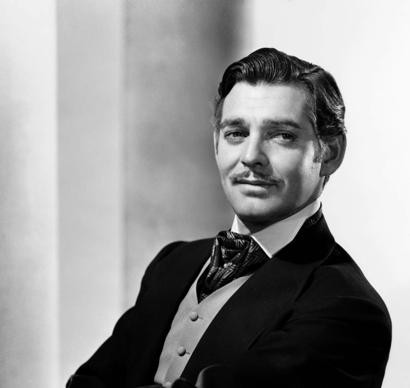
Clark Gable married five times, slept with nearly all of his co-stars, and cheated on everyone. In just about every movie in which he plays the romantic lead, he cajoles, spanks, slaps, or otherwise mistreats the object of his affection. In other words, he’s a bastard, but he’s one steamy bastard. And he challenged the image of the leading man in 1930s Hollywood, offering a barrel-chested alternative to the fleet-footed likes of Fred Astaire and Cary Grant. He looked very much as if someone had taken a swarthy pirate, given him a facial, parted his hair to the side, trimmed his mustache, and put him in tails. Years before Brando popularized the menace and gravitas that characterized a new generation of male stars, there was Gable, and shit did he smolder.
For all of Gable’s bad behavior, he never got caught. Apart from whispers and scolds in the gossip columns, his image remained relatively untarnished. His affairs — and the fruit of those affairs — were kept under wraps by the skillful Fixers at his studio, MGM. An action is never de facto scandalous: It becomes scandalous when it challenges the status quo. What’s fascinating about Gable, then, is how a womanizing drunkard remained free of scandal — and what made it so easy to do so.
Gable took a roundabout route to Hollywood. After a childhood in Ohio, he dabbled on the stage, eventually finding his way to Portland, Oregon, where he hooked up with a theater manager 17 years his senior. The woman was the first in a string of older women who took care of Gable, paid his bills, and helped him get jobs. In return, he cheated on them constantly. This one essentially made Gable movie star material: She paid for him to fix his teeth, cut and style his hair, and trained him out of his girly voice. They moved to Hollywood, where Gable paid his dues as an extra in silent films and toured with a stage company (his job: “servicing” theater star Jane Cowl). He traded in the first ingratiating woman for a second, wealthier one, and eventually earned a contract with MGM.
But the studio didn’t quite have a handle on his image, casting him as an unrepentant villain and a laundryman. This was akin to casting Channing Tatum as a bad guy or smart person, when everyone knows he should only be taking off his shirt and/or doing dance moves, preferably while in the rain. Even cast in the wrong roles, Gable was remarkable. MGM’s head of publicity thus decided to further refine Gable’s image, capitalizing on his rural past and six-foot frame to create Clark Gable, The Lumberjack in Evening Clothes.
In the early ’30s, this combination of the savage and the civilized would have been tremendously appealing. This image, like so many in Hollywood, underlined movies’ ability to transform the ordinary, midwestern, hard-working American. But Gable also represented a new type of Hollywood male: something less European, more American, less cosmopolitan, more rugged — all at a time when the growing Depression and the national frailty it betrayed called for popular idols who seemed to promise that the nation was still potent, white, and burly.
Gable was paired with every female star in the MGM stable: Norma Shearer, Greta Garbo, Joan Crawford. At this point, Crawford was already Hollywood royalty. Not only had she proven herself a “hey hey girl” second only to Clara Bow, she was married to Douglas Fairbanks Jr. — son of Douglas Fairbanks and step-son of Mary Pickford, the ruling couple of silent-era Hollywood. Now, I realize that when you read “Joan Crawford” images of Mommie Dearest and freaky Granny-face flash before your eyes, but make them go away and think of THIS girl instead.
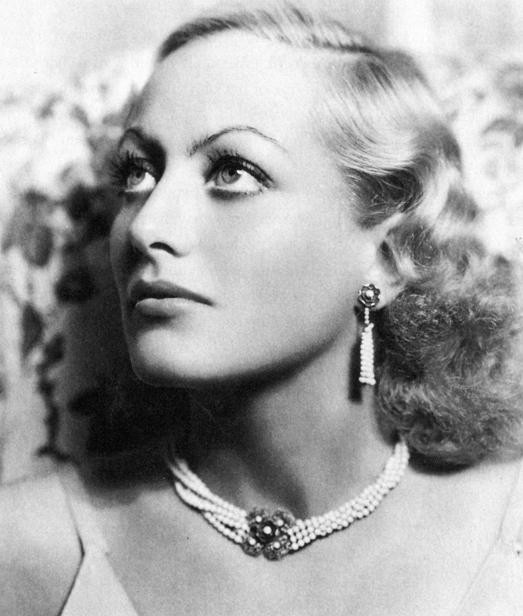
According to Crawford, the first time she met Gable “it was like an electric current went through my body … my knees buckled … if he hadn’t held me by the shoulders, I’d have dropped.” JOAN, I TOTALLY KNOW THE FEELING. That’s how I reacted when I realized the man next to me in hot yoga was Matt Saracen/a.k.a. QB1 of my heart, only he didn’t reach out and steady my shoulders in downward dog.
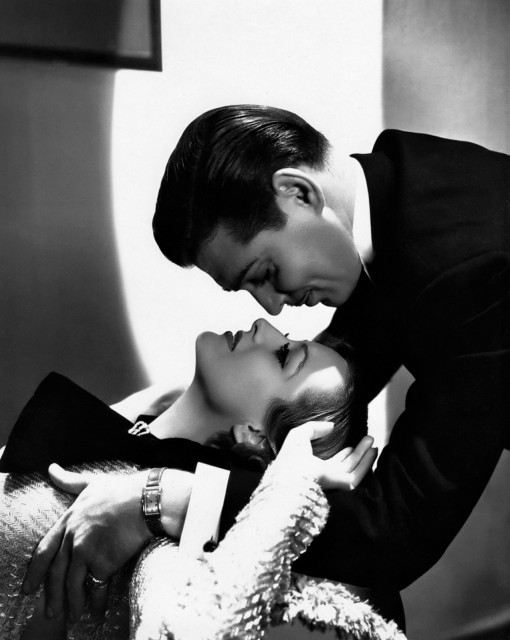
Thus began an on-and-off again affair that would last through eight films, three decades, and several marriages and divorces — just never to each other.
Gable and Crawford were so brazenly into each other — we’re talking early stages of Brangelina — that the honchos at MGM demanded they stop seeing each other, lest Gable’s apoplectic second wife go to the press. If the pair refused, MGM would activate the morality clauses in both of their contracts, and both stars would be out of a job. This was obviously a huge bluff, as MGM would never sacrifice two of its most valuable stars. But the studio needed to wrangle the two, especially since the fan magazines had begun to insinuate to millions of movie-goers what all of Hollywood knew to be true.
At this point, Gable was appearing in dozens of films, gradually accumulating more and more favor, perhaps most notably as a sweaty, stubbly, man-amongst-men opposite a negligee-clad Jean Harlow in Red Dust.
Then, in 1934, he appeared in It Happened One Night. Now take a deep breath, because I am going to say something that will blow your mind: THIS FILM MIGHT BE BETTER THAN GONE WITH THE WIND.
I know! Controversial! I realize that Gone With the Wind is a historical melodrama for all time. I realize it has great clothes. I realize it has motherfucking color. But It Happened One Night, like all the best screwball comedies from the 1930s, relies on wit, banter, charm, and well-placed physical comedy. It is a piquant delight to Gone With the Wind’s heavy souffle drenched in cream. Plus: THE HITCHHIKING SCENE!
You will love this movie, even if you really only love looking at the way Claudette Colbert’s eyebrows refuse to move. But whether or not you agree with me (and, believe me, I am already applying my internet armor for the attack that will come in the comments) what matters is that the film was a smash. It won the “Big Five” Academy Awards (Pictures, Director, Screenplay, Actor, Actress), including Gable’s first win. And it reaffirmed Gable as a huge star — and one of MGM’s most valued assets.
Which is also why MGM was so keen to cover up what came next. In 1934, Gable started filming Call of the Wild with child star-turned-ingenue Loretta Young. Young had been appearing in films since she was three years old, and by age 17, she had already eloped with her 26-year-old costar. The marriage was annulled a year later, leaving Young free for future exploits.
Young was by all accounts an early version of Mandy Moore in Saved!, only minus the praise songs and feathered hair. Case in point: She carried around a “swear jar” on set and demanded that every time someone cursed on set, he/she pay a quarter “for the nuns.” (Spencer Tracy’s reply: “Here’s a twenty, sister. Go fuck yourself.”) Which isn’t to say that Young didn’t get around — she totally did — she just played the religious virgin card to her benefit. Gable, still married, still on the prowl, and so not her apparent type, must have been hard to resist.
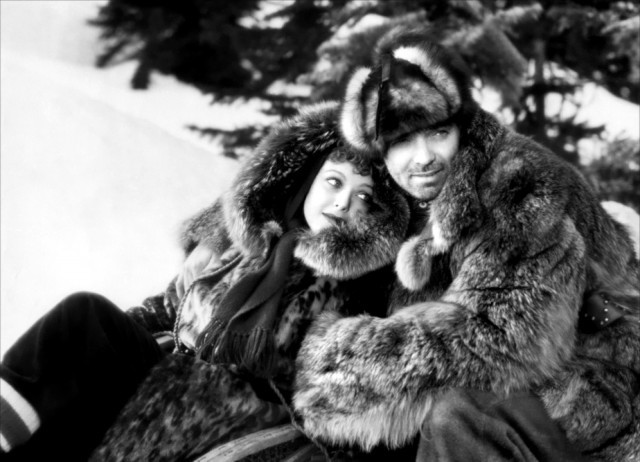
(Oh hey Loretta, wanna go back to our trailers and make out in our matching wolf coats?)
Cut scene, fade to black, and return with Young pregnant with Gable’s child. Most stars in her condition were hospitalized for “exhaustion” or nerves (read: got abortions), but the Catholic Young refused. Instead, she pulled what might be the greatest Hollywood non-publicity stunt of all time.
1) She hides the pregnancy.
2) When she begins to show, she flees to England “on vacation.”
3) When people start asking where the hell she is, she says that she’s dealing with a “condition from childhood.”
4) She somehow smuggles herself back to her mom’s house in Venice, California, where she gives birth. I’m picturing nuns in gray, with lots of whispering and pulling of the drapes.
5) She sends the baby to an orphanage, trims herself down, and goes back to work.
6) 19 months later, she tells Louella Parsons that she plans to adopt “two babies” and embrace the life of a single mother.
7) She picks up her daughter at the orphanage, then tells the press “Oops! Second baby got reclaimed, Imma just adopt this one baby WHO LOOKS SO MUCH LIKE MEEE!!!!” (This might be the point when Mandy Moore in Saved! drives her minivan into the tree).
8) She refuses to tell her daughter the identity of her real parents, even when the daughter’s HUGE CLARK GABLE EARS betray her true identity to all of the world. (According to lore, the daughter only learned that Gable was her father when some grade school brat told her so.)
But again — and this is crucial — no matter how much people gossiped about this child’s ears as she grew older, it was a rumor, not a scandal. Young, working with the help of the MGM Fixers, wove a tale that seemed believable.
Jump to 1939. Gable divorces wife #2, marries comedienne/American sweetheart Carole Lombard, and became Rhett Butler. I’m not going to talk about Gone With the Wind much, other than to say that it was and remains the most successful movie of all time, and if Clark Gable wasn’t your star boyfriend before that movie, he certainly was afterward.
Gable was at the height of his career, with a new, glamorous, equally famous wife by his side. Sure, he was still a bit of a scoundrel, but he, like other rascally, unapologetically masculine men, found that the love of a good woman — a woman his intellectual and spiritual match — had reformed him. In this way, Gable, the man who made a game of sleeping with all the female talent on the MGM lot, was sold as Lombard’s doting husband.
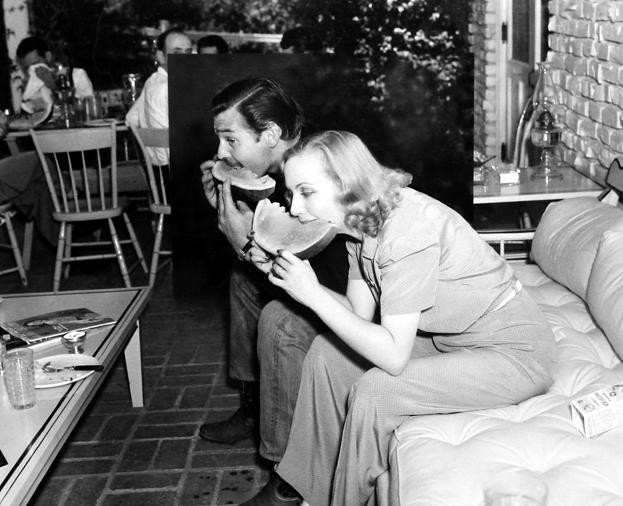
The above picture is a publicity shot, but it sure looks genuine. And, of course, just because it’s a Hollywood love story doesn’t mean it wasn’t real. And in 1942, their marriage was immortalized when Lombard, on her way home from a War Bond promotional tour, was killed in a plane crash. Gable, devastated, went on a drinking binge, and enrolled in the Air Force. But this was no Prince Harry hidden in Afghanistan: Gable, like Jimmy Stewart and several other male stars, flew actual combat missions.
I cannot imagine how heroic this guy must have seemed. Here was Rhett Butler, tragic widower, flying for his country. But when he returned to Hollywood post World War II, the magic had gone out of him — or, more precisely, his type of masculinity no longer seemed exactly the right fit for the nation. His star dimmed as those of other actors with slightly more fitting images, whether John Wayne, Burt Lancaster, Rock Hudson, or James Dean, eventually took his place.
So here’s the thing: Gable was essentially a manwhore. He was a drunk, a manipulator, and, most likely, a huge, albeit rather likable, ass. But MGM managed to channel that debaucherous energy into an image that was at once potent, compelling, and enormously attractive to men and women alike. He was the right kind of man for the right decade, and the meticulous machine at MGM made it easy to paper over the worst of his indiscretions.
In the end, Gable’s actions were no more or less “scandalous” than those of today — it’s just that the cover up was better. There was complete cooperation between the studios and the gossip entities, there was no paparazzi to speak of, AND THERE WAS NO INTERNET. Gable did what he wanted with little recourse, and he could do so because he was the biggest star in the biggest and best-run studio during a decade when America clung to movies and the stars in them. If you think about it, Gable probably had more sex than Justin Timberlake, Alex Rodriguez, and Brad Pitt, and he had that sex with Hollywood’s most beautiful women.
Most importantly, he didn’t have to pay for it, literally or figuratively. And before you argue that he got away with it because he was a man, recall that Joan Crawford, Greta Garbo, Marlene Dietrich, and Mae West were doing the same thing, with men and women alike. If anything, the studio control meant that both sexes could exercise their sexuality, whereas today men get a (heterosexual) free pass while female celebrities get called desperate, slutty, cougars, or otherwise unruly.
Historians call the 1930s the “Golden Age of Hollywood.” They are referring, of course, to the films. But it was also the golden age of the star-making machine, a machine so well-oiled it could’ve polished Lindsay Lohan c. 2011 into a national treasure.
Sure, it was smoke and mirrors, and if you pay me $10, I’ll write you a solid Marxist critique of Hollywood Stars as New Opiate of the Masses. But I guess I’m kinda fatigued with dick-shot Twitpics and Jennifer Aniston’s half-assed attempts to conjure a romance with her latest co-star. Maybe just give me a good scandal cover-up for my grandkids to relish? A love child that doesn’t have anything to do with January Jones? I’ll wait.
Previously: Clara Bow, “It” Girl.
Anne Helen Petersen is a Doctor of Celebrity Gossip. No, really. You can find evidence (and other writings) here.